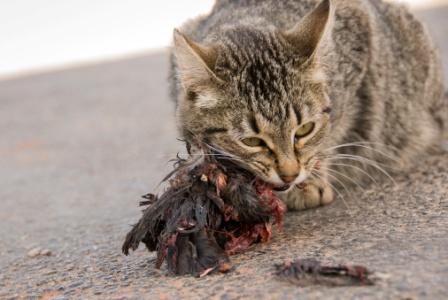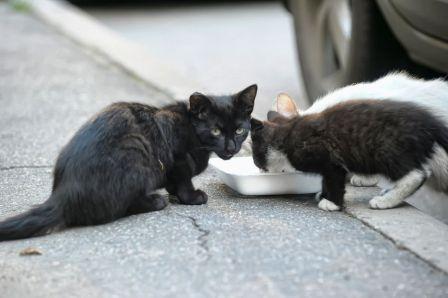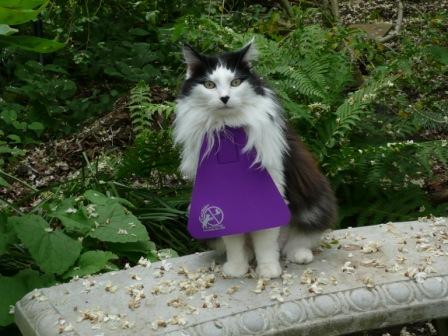
The news item was of passing interest, probably, to most people. A study published in a science journal reported in late January that cats kill far more birds and small mammals than was previously believed. The media jumped on the story, and for two days it was on every news outlet. Then, as with most headlines in the 24-hour news cycle, it slipped into the realm of trivia.
For animal advocates, though, it was just the opening salvo in what is sure to become a long fight—or already is one. What appears on the surface to be a simple case of bird-lovers versus cat-lovers is actually a much larger conflict exposing the gulf that exists between advocates of wildlife and of animal rights.
It’s not the only gap in the world of animal-loving political causes, of course. This one is notable, though, because it focuses on one species: the utterly common, utterly unique domestic cat. Among pets, cats alone have remained half wild despite being domesticated for centuries. They are the only domestics in which an individual animal raised in captivity can actually revert to semi-feral status. And this is what has put the cat in the crosshairs of a growing war.
For anyone who managed to miss the story, a study by the Smithsonian Conservation Biology Institute in conjunction with the U.S. Fish and Wildlife Service analyzed the most scientifically rigorous studies done over the last century to calculate the effect of cat predation on wildlife—a number that had been guessed at for years, but never known. The researchers discovered that cats kill an average of 2.4 billion birds and 12.3 billion mammals each year, a finding they called “shockingly high.” Moreover, the victims were mostly native species rather than introduced pests, pointing to the domestic cat as one of the greatest human-caused threats to wildlife.
Birdwatchers, wildlife advocates, and wildlife rescuers cheered. They had been arguing for years that cats—the most abundant carnivore on the continent—are non-native predators allowed to multiply to the point of decimating threatened species. Just as quickly, cat advocacy groups cried foul. The national advocacy group Alley Cat Allies condemned the “junk science” behind the report as “a veiled promotion by bird advocates to ramp up the mass killing of outdoor cats.” Cat rescue groups such as the highly respected Best Friends Animal Sanctuary in Utah attacked the researchers’ motivations, saying their study was designed only “to directly attack nonlethal programs for outdoor cats and all who support them.”
Trap-Neuter-Return
Cat advocates were, in fact, seeing clearly when they questioned the objectives of the Smithsonian study. The target was indeed—and has been for years—the hunting habits of feral cats, and thus the increasingly popular cat management model known as trap-neuter-return (TNR).
Pet cats, it turns out, are the lesser part of the predation problem. Backyard hunters do account for 29 percent of bird deaths and 11 percent of mammals.’ But everyone seems to agree that the problem originates with irresponsible owners who let their cats roam or abandon them, leading to the nation’s estimated 80 million feral cats. It is these animals, the ones that hunt all the time, that account for the vast share of wildlife deaths.
Until recently, the routine solution to cat overpopulation was euthanasia. Cats were rounded up and gassed. Kittens were drowned soon after birth. But with the growth of the animal rights movement, a more humane method of dealing with feral cats has emerged in which strays are trapped, sterilized, then returned to wild colonies that are fed and cared for, presumably until all the cats die out. Pioneered by groups like Best Friends Animal Sanctuary, and endorsed by the ASPCA and many veterinary groups, TNR was introduced in Albuquerque by Animal Humane in 2008.
“It is the best way to manage the feral cat problem, which I would say is a reality of all urban areas,” says Dawn Glass, Animal Humane spokesperson. After two years of TNR, Animal Humane started seeing a decrease in kitten intakes, which have declined every year since. In fiscal 2011, kitten intakes were down 21 percent, a reversal that could not be attributed to any cause other than the 2,250 cats sterilized through TNR that year, Glass said. (Kittens brought to shelters are nearly all feral.) Last year, she added, City of Albuquerque shelters had a 40 percent reduction in euthanasia rates for all animals. “We have proven results that it is reducing the number of cats in shelters in our city.”
Corrales bird rescuer Mikal Deese shakes her head. “I really wish that TNR worked,” she says, “because emotionally it’s so much better a response. But the only place it’s ever worked is on an island.” Opponents of TNR marshal their own studies to show that cat colonies not only are the main culprits in bird deaths, the strategy doesn’t even work to reduce the feral cat population. New cats arrive until the colonies reach their available food limit, creating ever-larger densities of predators, they say. And since abandoned house cats are not very practiced hunters, feeding by humans is needed to sustain them so they can keep hunting. At least 70 percent of cats in a colony have to be sterilized to impact the population, according to studies cited by the Wildlife Society—a figure rarely met by TNR programs.
“We’re seeing over and over again wildlife being caught by pets, and they aren’t hungry. There are now more cats than ever before,” says Deese, a bird rehabilitator at Wildlife Rescue Inc. who has seen six baby birds in a row brought in to the center because of cat attack. “Fledgling birds are the victims.” She lists some 14 wildlife agencies that are calling for an end to feral cat colonies, including the International Association of Fish and Wildlife Agencies, National Association of State Public Health Veterinarians, Audubon Society, PETA, Wildlife Society, and the law enforcement office of the U.S. Fish & Wildlife Service.
“Cats are not native here,” adds Deese, echoing the frustration of many wildlife advocates who believe ecosystem health trumps concerns about animal welfare. “We have released this predator that’s not part of the ecology. I’m not trying to take away anyone’s cat that’s indoors,” she adds. “It’s that we’ve loosed them on all the other creatures on the continent.” Cats, she adds, have led to the extinction of bird species on several islands, and impact 245 species of threatened or near-threatened birds.
An animal-lover herself, Deese is ready to concede that the alternative to TNR is trap and euthanize, a position that scandalized cat rescuers last month when expressed by Audubon editor-at-large Ted Williams in the Orlando Sentinel. In a vitriolic editorial March 14, Williams recommended poisoning feral cats with Tylenol as an “effective, humane alternative to the cat hell of TNR.”
Such talk only confirms the worst fears of cat rescuers. “What kind of morality do you have when you want one animal killed instead of another?” says Glass. Advocates fear the kind of extremism reported in New Zealand, where the loss of indigenous birds—nearly all of them flightless ground-nesters—has led economist Gareth Morgan to advocate an end to cats on the island. This position apparently has freed zealots to kill cats on sight, according to Bosque Beast columnist Kat Brown, who communicates with cat advocates on that island.
Like many cat-lovers, Brown questions the science behind the Smithsonian study, which did not include bird deaths from other human-caused factors (the most significant by far being habitat destruction) or distinguish the loss of birds that were injured or weak and would have died anyway. “In controlled circumstances (which many cat communities are) the population will decrease every time a cat is spayed or neutered,” she notes, adding that “barn cats” that are well fed tend to chase intruders out of their territory, rather than hunt food. “Spaying and neutering all cats, both indoor and feral, will lessen the urge to roam and fight and hunt.”

Cats indoors
The argument over what to do about feral cats—kill them or feed them—is not new, though publicity about the problem may be. In fact, the debate may ring familiar to defenders of coyotes, wild horses, and wolves—all “problems” created by human domestication of animals. Recognizing that neither side can prevail in such fights, groups like the American Bird Conservancy are taking the long view by putting the focus on responsible pet ownership. Through its Cats Indoors campaign, which aims to convince pet owners to keep cats inside, ABC hopes to launch a large-scale cultural change in how Americans think of cats, as happened in the case of smoking.
“We used to have packs of wild dogs,” says Deese, “but we realized the danger of that, so we changed our minds about allowing loose dogs.” Brown agrees. “There is absolutely no reason a cat needs to go outside. That notion is just plain ignorance, and it leads to all kinds of bad situations for cats.” Feral cats have an average life expectancy of four years, compared with 14 for pets. In New Mexico, free-roaming cats are themselves subject to predation by coyotes.
That may explain why feral cats are not much of a “problem” in rural New Mexico. Corrales Animal Control officer P. “Frosty” Frostensen says he has not seen nor heard evidence of anyone feeding cat colonies in Corrales. “Because ours is a semi-rural environment, they are part of the ecology of the system,” concurs Barbara Bayer of the mostly-cat rescue group CARMA. “Sadly, food for predators as well as predators themselves. We have pockets of ferals in Corrales, and people who refuse to keep their cats indoors for the misguided reason that they feel cats need to be outside. So the two are ineluctably linked.”
Where predators exist, in other words, the overpopulation problem is quickly resolved, not least because cat owners are motivated to keep their pets inside. In more densely populated areas, where predators are limited to automobiles and little boys with slingshots, cats are bound to fall prey to political predation, whether by well-meaning TNR programs or by the less sentimental animal-catcher.
The ultimate loser in this culture war may be lax cat owners, who alone have no group lobbying for their rights, just as anti-smoking fervor took its final toll not only on smokers, but on tobacco companies. And not only as Internet memes, but in legal and financial penalties.

Tame the hunter
There are several measures that cat owners can take to make their friends’ hunting instincts less deadly. Forget the traditional bell on the collar—it usually doesn’t work, as birds don’t perceive the sound as a warning. “It’s the last sound the bird hears,” as one bird-lover told us. What does appear to work is an Australian product called the Cat Bib. Its bright colors seem to warn birds, while the bib itself might hinder the cat’s stealthy pounce. Locally the product is available at The Fat Finch in the North Valley.
Another way to let your cat enjoy the outdoors safely is to install an enclosure in the yard or on the window, or cat-proof your fence. Products and do-it-yourself instructions are available online for anyone, whether strapped for time or money—so no excuses. The advantage of an enclosure is that it works for any number of cats, and also keeps your predators from becoming prey. Of course the simplest solution is just to keep the felines inside.
